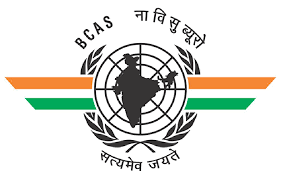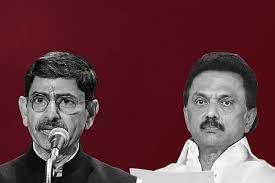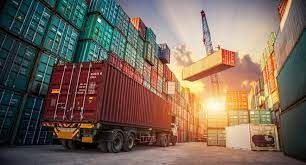UPSC Daily Current Affairs- 25th April 2023 | Current Affairs & Hindu Analysis: Daily, Weekly & Monthly PDF Download
GS-I
Zafar Mahal
Why in News?
The Archaeological Survey of India (ASI) is set to initiate conservation works at Zafar Mahal in south Delhi’s Mehrauli.
About Zafar Mahal:
- This is the last structure built by the Mughals and served as a summer palace for the Mughal family.
- Location: It is located in Mehrauli village, which is in the Southern part of Delhi.
- It was built in memory of the Hazrat Khwaja Qutubuddin Bakthiar Kaki, the renowned Sufi saint to whom almost all the Mughal Emperors were disciples.
- Zafar Mahal stands next to the Dargah of Qutubuddin Bakhtiyar Kaki.
- It was started by Emperor Akhbar Shah II and was finished by the last Mughal emperor, Bahadur Shah Zafar, who also gave it the present name of Zafar Mahal.
- It consists of two components: one being the Mahal or the palace which was established by Akbar Shah II during 18th century and the other being the entrance gate (Hathi Gate) that was developed during 19th century by Bahadur Shah Zafar II.
- The Zafar Mahal complex also contains some cenotaphs of the later Mughal Emperors.
- The famous festival or the annual procession known as Phulon ki Sair also starts from here and is a festival that had long ago been started by the Khawja Bhaktiyar Kaki himself as a protest against the British.
Source: Hindustan Times
GS-II
BCAS
Why in News?
The Bureau of Civil Aviation Security (BCAS) recently cited the security advisory issued on the basis of the threat perception, to the opposition raised by the passengers about the double metal-detector based checking at the airports.
About Bureau of Civil Aviation Security (BCAS):
- It was initially set up as a Cell in the Directorate General of Civil Aviation in January 1978 on the recommendation of the Pande Committee.
- It was reorganized into an independent department under the Ministry of Civil Aviation on 1st April 1987.
- The main responsibilities of BCAS include laying down standards and measures with respect to the security of civil flights at international and domestic airports in India.
- Headquarters: New Delhi
- It has got four Regional Offices located at International airports i.e. Delhi, Mumbai, Kolkata and Chennai.
- Functions:
- Laying down Aviation Security Standards in accordance with Annex 17 to the Chicago Convention of International Civil Aviation Organization (ICAO) for airport operators, airline operators, and their security agencies responsible for implementing AVSEC measures.
- Monitoring the implementation of security rules and regulations and carrying out survey of security needs.
- Ensure that the persons implementing security controls are appropriately trained and possess all competencies required to perform their duties.
- Planning and coordination of Aviation security matters.
- Surprise/Dummy checks to test the professional efficiency and alertness of security staff.
- Mock exercise to test the efficacy of Contingency Plans and operational preparedness of the various agencies.
Key Facts about Directorate General of Civil Aviation (DGCA):
- It is the regulatory body in the field of Civil Aviation, primarily dealing with safety issues.
- It is responsible for regulation of air transport services to/from/within India and for enforcement of civil air regulations, air safety, and airworthiness standards.
- The DGCA also coordinates all regulatory functions with the International Civil Aviation Organisation (ICAO).
- The headquarters are located in New Delhi with regional offices in the various parts of India.
What is the Chicago Convention?
- The Chicago Convention (also known as the Convention on International Civil Aviation), established the International Civil Aviation Organisation (ICAO), a specialized agency of the United Nations charged with coordinating and regulating international air travel.
- The Convention was signed by 52 states on 7 December 1944 in Chicago, U.S., and came into effect on 4 April 1947.
- It establishes rules of airspace, aircraft registration and safety and details the rights of the signatories in relation to air travel.
- The Convention also exempts air fuels from tax.
- The Convention provided for the sovereignty of airspace above the territory of each state, together with five freedoms (later expanded to nine by the addition of four unofficial freedoms) which govern the freedom of states to operate air transport flights (including the carriage of passengers, cargo and mail) across, into and within the airspace of other states.
Source: PIB
Network of Groundwater Sensors

Why in News?
The Jal Shakti Ministry is working on an ambitious plan to deploy a vast network of groundwater sensors.
More about News
- It will continuously relay information on groundwater levels as well as the degree of contamination down to the taluk level.
- Currently, such data is only measured a few times each year and communicated through Central Groundwater Board publications.
67,000 recordable units in the future
- Under the new initiative, around 16,000-17,000 digital water level recorders will be connected to piezometers in the wells (Piezometers measure groundwater levels, the recorders will transmit the information digitally)
- In the next three years India will have about 67,000 digitally recordable units to monitor groundwater dynamics.
Benefits of Network
- It will provide farmers with groundwater forecasts that would be useful for sowing
- Updated advisories that could influence groundwater extraction policies by states.
- Except for information on water flow governed by international treaties, most of this information will be publicly accessible.
Source: The Hindu
Governor’s Constitutional Limits: A Resolution to President
Why in News?
The Tamil Nadu Governor’s recent statement implying that he would not give assent to a Bill passed by the legislature if it transgresses constitutional limits has resulted in the Tamil Nadu Assembly passing a resolution requesting the President of India to issue directions to the Governor to function within constitutional limits.
Who is Governor?
- Parallel to President: The Governors of the states of India have similar powers and functions at the state level as those of the President of India at the Central level.
- Nominal head: The governor acts as the nominal head whereas the real power lies with the Chief Ministers of the states and her/his councils of ministers.
- Similar offices: Governors exist in the states while Lieutenant Governors or Administrators exist in union territories including the National Capital Territory of Delhi.
- Non-local appointees: Few or no governors are local to the state that they are appointed to govern.
New Constitutional Development
- Passing a resolution by the Assembly requesting the President of India to ensure that the Governor functions within the Constitution is a new constitutional development.
What are the relevant articles?
- Article 355: Article 355 of the Constitution states that it is the duty of the Union to ensure that every State’s government is carried out according to the Constitution.
- R. Ambedkar on Article 355: While the general meaning and purpose of Article 355 was explained by B.R. Ambedkar in the Constituent Assembly, the Constitution’s concepts and doctrines have been interpreted and reinterpreted to meet society’s changing needs
- Article 200: Although Article 200 provides options to the Governor when a Bill is presented to him after being passed by the legislature, withholding assent is not an option given by the Constitution.
Governor’s Discretionary Powers and the confusion of Withholding assent
- Options to the Governor: Article 200 provides options to the Governor when a Bill is presented to him after being passed by the legislature.
- These options are:
- To give assent;
- To withhold assent;
- To send it back to the Assembly to reconsider it; or
- To send the Bill to the President for his consideration.
- Idea of the Third option: In case the Assembly reconsiders the Bill as per the request of the Governor under the third option, he has to give assent even if the Assembly passes it again without accepting any of the suggestions of the Governor.
- One of the options is required to be exercised: It is only logical to think that when the Constitution gives certain options to the Governor, he is required to exercise one of them.
- Sitting on the bill goes against the constitutional direction: Since sitting on a Bill passed by the Assembly is not an option given by the Constitution, the Governor, by doing so, is only acting against constitutional direction. A judicial pronouncement on this matter is needed to eliminate the confusion.
The issue of justiciability
Whether the process of assent by the Governor is subject to judicial review?
- Not justiciable: According to D.D. Basu, quoting judgments of the Supreme Court, it is not justiciable.
- For instance, Purushothaman Namboothiri vs State of Kerala (1962): In this case the court held that a Bill which is pending with the Governor does not lapse on the dissolution of the Assembly, but this judgment did not deal with the justiciability of the process of assent.
- Hoechst Pharmaceuticals Ltd. And vs State Of Bihar And Others (1983): In this case the court dealt with the power of the Governor to reserve a Bill for the consideration of the President, and held that the court cannot go into the question of whether it was necessary for the Governor to reserve the Bill for the consideration of the President.
- Government can challenge the inaction of the Governor in a court of law: The issue that is agitating State governments is the non-decision/indecision on the part of the Governor on a Bill passed by the Assembly. Therefore, the government can challenge the inaction of the Governor in a court of law, and the answer seems to be in the affirmative.
Way ahead
- Ensuring constitutional principles are upheld: The state governments and the Governor’s office should work together to establish a mutual understanding of the constitutional provisions and procedures for assent to a bill, with a focus on expediting the process while ensuring constitutional principles are upheld.
- Avoiding confrontation and legal battles: In case of disagreements between the state government and the Governor, the matter should be resolved through dialogue and mutual agreement, rather than resorting to confrontation and legal battles.
- Clarity on the issues of justifiability: The Supreme Court could provide clarity on the issue of justiciability of the Governor’s role in assent to a bill, while keeping in mind the constitutional provisions and the principles of federalism.
- Judicious use of discretionary powers: The Governor should exercise his discretionary powers judiciously and in line with constitutional provisions, without delaying or withholding assent to a bill without any valid reason.
- Transparent and consultative mechanism: The state government should ensure that bills are passed in a transparent and consultative manner, and the Governor should give due consideration to the views and opinions of all stakeholders before exercising his discretion.
- Promoting cooperative federalism: There should be a greater emphasis on promoting cooperative federalism, where the Centre, states, and governors work together in a spirit of collaboration and cooperation, while ensuring the protection of the Constitution and the rights of all citizens.
Conclusion
The framers of the Constitution would never have imagined that Governors would sit on Bills indefinitely without exercising any of the options given in Article 200. This is a new development which needs new solutions within the framework of the Constitution. So, it falls to the Supreme Court to fix a reasonable time frame for Governors to take a decision on a Bill passed by the Assembly in the larger interest of federalism in the country.
Source: The Hindu
GS-III
India’s Growing Logistics Sector
Why in News?
According to World Bank's Logistic Performance Index (LPI) 2023, India has climbed six places, now ranking 38th in the 139 countries index, as a result of significant investments in both soft and hard infrastructure as well as technology.
- India's performance has drastically improved from 2014 when it was ranked 54th on the LPI.
Logistics Sector
- The logistics industry comprises all supply chain activities, mainly transportation, inventory management, the flow of information, and customer service.
- Logistics is essential for the economy of a country. It pertains to the general method of controlling how resources are obtained, housed, and delivered to their ultimate location.
- It is a differentiating sector that can largely affect any country’s exports, thereby adding a significant competitive edge, with the underlying assumption of a robust logistics sector.
- It determines the success of not only the country’s supply chain but also influences it on a global scale.
India’s Potential
- The logistics industry in India is witnessing rapid growth owing to infrastructure, technology, and the emergence of new types of service providers that are reshaping the sector by reducing logistics costs and providing effective services.
- Moreover, government policies on taxation and regulation play a huge role in the improvisation of the sector.
- The government is going by certain estimates which suggest that logistics cost in India stands at about 13-14 percent of the country's GDP.
- The Economic Survey 2022-23 pointed out that logistics costs in India have been in the range of 14-18 percent of GDP against the global benchmark of 8 percent.
Challenges
- Inadequate infrastructure and weak fiscal policies in developing countries such as India result in high transport costs.
- During the lockdown’s most rigid stages, road transportation for large movements of goods was fraught with challenges and difficult to manage.
Government Initiatives
- Prime Minister Narendra Modi-led government announced the PM Gati Shakti's initiative, a National Master Plan for multimodal connectivity, in October 2021 to reduce logistics costs and boost the economy by 2024-25.
- In 2022, the Prime Minister launched the National Logistics Policy (NLP) to ensure quick last-mile delivery, end transport-related challenges, save time and money for the manufacturing sector and ensure desired speed in the logistics sector.
- Logistics Master Plan: This initiative takes a geographical strategy as opposed to an industry approach. Several projects and activities will be integrated into the plan to expand the mix of intermodal and/or multimodal transportation. Coordinated construction of relevant infrastructure (gas and utility pipelines, optical fiber cable networks) is accordingly planned.
- National Logistics Law: A national logistics law has been drafted and is under consultation. Through a unified legal framework for the paradigm of One Nation, One Contract, it would support the One Nation, One Market objective and provide a flexible regulatory environment (single bill of lading across modes).
- The law's provisions will make it possible to assign a distinct logistics account number in place of cumbersome registration processes.
- National Multimodal Facilities and Warehousing: In order to promote intermodal and Multimodal Logistics Parks (MMLPs) as a separate class of infrastructure, the National Grid of Logistics Parks and Terminals is being planned.
- National Logistics Workforce Strategy: For the integrated skill development of professionals in the logistics sector, the government is developing a national logistics workforce strategy.
Suggestions and Way Forward
- The initiatives taken by the government will lead to the progress of the logistics sector.
- The integration in the form of a multi-modal network of transport and warehousing will lead to increased efficiency in the transportation and storage of goods throughout the country.
- There is also a need for better warehousing, cold storage infrastructure and enhanced first and last-mile connectivity to reduce wastage and promote quicker transport of goods from port to port, city to city, and from state to state.
- There is also an opportunity to promote sustainability within this space, by incentivizing players to adopt electric vehicle (EV) infrastructure for commercial purposes to improve last-mile delivery services, while reducing the carbon footprint of the industry.
Source: The Hindu
LockBit Ransomware
Why in News?
Recent reports emerged that for the first time, the LockBit Ransomware was found to be targeting Mac devices.
About LockBit Ransomware:
- It is malicious software designed to block user access to computer systems in exchange for a ransom payment.
- It was formerly known as “ABCD” ransomware, but it has since grown into a unique threat within the scope of extortion tools.
- It is a subclass of ransomware known as a ‘crypto virus’ due to forming its ransom requests around financial payment in exchange for decryption.
- It focuses mostly on enterprises and government organizations rather than individuals.
- It functions as ransomware-as-a-service (RaaS). Willing parties put a deposit down for the use of custom for-hire attacks, and profit under an affiliate framework.
How does LockBit ransomware work?
- It works as a self-spreading malware, not requiring additional instructions once it has successfully infiltrated a single device with access to an organisational intranet.
- It is also known to hide executable encryption files by disguising them in the . PNG format, thereby avoiding detection by system defences.
- Attackers use phishing tactics and other social engineering methods to impersonate trusted personnel or authorities to lure victims into sharing credentials.
- Once it has gained access, the ransomware prepares the system to release its encryption payload across as many devices as possible.
- It then disables security programs and other infrastructures that could permit system data recovery.
Source: The Hindu
Overuse of Urea in India and its Implications

Why in News?
The use of urea has continued to increase, leading to a decline in crop yield response to fertiliser use, and an imbalance in the nutrient application.
- Unbalanced fertilization: The nutrient-based subsidy regime is a failure in promoting balanced fertilization.
- Several measures failed: The measures introduced by the Indian government to reduce urea consumption, such as neem-coating, smaller bags, and Nano Urea, have not been successful.
What is Urea?
- Urea is a commonly used nitrogen-containing fertiliser that provides crops with the necessary nutrients for growth and development.
- It is a white, crystalline solid that is soluble in water and has a high nitrogen content, with around 46% nitrogen by weight.
- Urea is made from ammonia and carbon dioxide and is used extensively in agriculture due to its high nitrogen content and affordability.
- It is a major source of nitrogen for crops, and when applied in the right amounts, it can improve crop yields and increase overall agricultural productivity.
Policy moves related to Urea
The introduction of these measures was aimed at reducing urea consumption in the country.
- Neem-coated urea: In May 2015, the Indian government mandated the neem-coating of all urea manufactured in the country as well as imported urea to illegal diversion for non-agricultural use.
- Reduced size: Later, in March 2018, the government replaced 50-kg urea bags with 45-kg bags.
- Liquid Nano Urea: Recently, in June 2021, the Indian Farmers’ Fertiliser Cooperative (IFFCO) launched a liquid fertiliser called ‘Nano Urea’.
Ineffectiveness of the above measures
- Despite the introduction of these measures, urea consumption in the country has not decreased.
- In fact, sales of urea crossed a record 35.7 million tonnes (mt) in the fiscal year ended March 31, 2023.
- Although consumption dipped in the initial two years after neem-coating was fully enforced, it reversed from 2018-19.
Failure of the nutrient-based subsidy (NBS) regime
- The government introduced the nutrient-based subsidy (NBS) regime in April 2010.
- The regime fixed a per-kg subsidy for each fertiliser nutrient – nitrogen (N), phosphorus (P), potash (K), and sulphur (S).
- The aim was to promote balanced fertilisation and discourage farmers from applying too much urea, di-ammonium phosphate (DAP) and muriate of potash (MOP).
- However, the data shows that nutrient imbalance has worsened, with urea consumption rising by over a third since 2009-10.
- Nitrogen use efficiency (NUE) has declined from 48.2% in 1962-63 to 34.7% in 2018.
Cost of overdose fertilization
- Fertilisers are essential for plant growth and grain yield, but the overuse of urea and other fertilisers has led to an imbalance in nutrient application.
- Crop yield response to fertiliser use has decreased, with the disproportionate application of nitrogen by farmers being a key reason.
- Recent research has shown that nitrogen use efficiency has declined in India, making it necessary to promote the use of other fertilisers containing different nutrients.
Way forward
To address the issue of rising urea consumption, two approaches can be adopted.
- Disincentivise: The first is to raise prices, but this is not politically feasible.
- Improve nitrogen use efficiency (NUE): One way to achieve this is to make the incorporation of urease and nitrification inhibitors compulsory in urea.
Some other potential solutions include:
- Promoting the use of organic fertilisers: Such as compost and manure, can improve soil health and reduce the need for synthetic fertilisers. This can also reduce the risk of environmental pollution and improve the sustainability of agriculture.
- Encouraging precision agriculture: Such as soil testing, can help farmers apply fertilisers in the right amounts and at the right time, reducing wastage and increasing nutrient use efficiency.
- Promoting crop rotation and intercropping: Planting different crops in rotation or together can help maintain soil fertility and reduce the need for synthetic fertilisers.
- Increasing public awareness and education: Educating farmers and the public on the importance of sustainable fertiliser use and the potential risks of overusing synthetic fertilisers can help promote more sustainable agricultural practices.
Source: The Hindu
EU’s Markets in Crypto Assets (MiCA)
Why in News?
The European Parliament recently approved the cryptocurrency regulation “Markets in Crypto Assets (MiCA)”.
More about the new rules
- MiCA will impose compliance on the issuers of crypto assets, who are defined as the “legal person who offers to the public any type of crypto-assets”.
- It will apply to crypto-asset service providers (CASPs) providing one or more of these services.
- The operation of a trading platform like CoinBase, custody, and administration of crypto assets on behalf of third parties (customers),
- The exchange of crypto assets for funds/other crypto-assets,
- The execution of orders for crypto assets,
- The placing of crypto assets, providing transfer services for crypto assets to third parties, providing advice on cryptoassets and crypto-portfolio management.
- Authorisation & CASPs:
- The base regime will require every CASP to get incorporated as a legal entity in the EU.
- They can get authorised in any one member country and will be allowed to conduct their services across the 27 countries.
- Supervision of CASPs:
- They will then be supervised by regulators like the European Banking Authority and the European Securities and Markets Authority, who will ensure that the companies have the required risk management and corporate governance practices in place.
- Responsibility of CASPs:
- CASPs will have to demonstrate their stability and soundness, ability to keep the funds users safe, implementation of controls to ensure they are not engaging in proprietary trading; avoidance of conflicts of interest, and their ability to defend against market abuse and manipulation.
MiCA regulations
- Cryptoassets:
- The MiCA legislation will apply to ‘cryptoassets’, which are broadly defined in the text as follows:
- “A digital representation of a value or a right that uses cryptography for security and is in the form of a coin or a token or any other digital medium which may be transferred and stored electronically, using distributed ledger technology or similar technology”.
- This definition implies that it will apply not only to traditional cryptocurrencies like Bitcoin and Ethereum but also to newer ones like stablecoins.
- The MiCA legislation will apply to ‘cryptoassets’, which are broadly defined in the text as follows:
- Stablecoins:
- Stablecoins are digital tokens that aim to stay pegged in value with a more stable asset - a fiat currency like the U.S. dollar or other stable cryptocurrencies.
- MiCA will establish new rules for three types of stablecoins — asset-referenced tokens, which are linked to multiple currencies, commodities, or cryptocurrencies, e-money Tokens, which are linked to a single currency and utility tokens, which are intended to provide access to a good or service that will be supplied by the issuer of that token.
Exemptions
- Transferable securities:
- As for the assets that will be out of MiCA’s scope, it will not regulate digital assets that would qualify as transferable securities and function like shares or their equivalent and other crypto assets that already qualify as financial instruments under existing regulation.
- Non Fungible tokens (NFTs):
- It will also, for the most part, exclude non fungible tokens (NFTs).
- Central bank digital currencies & digital assets:
- MiCA will also not regulate central bank digital currencies issued by the European Central Bank and digital assets issued by national central banks of EU member countries when acting in their capacity as monetary authorities, along with cryptoassets-related services offered by them.
Significance of MiCA
- Harmonising crypto industry:
- According to Chainalysis, about 22% of the global crypto industry was concentrated in central, northern, and western Europe, which received $1.3 trillion worth of crypto assets.
- Having a comprehensive framework like MiCA for 27 countries in Europe not only harmonises the crypto industry but also gives the EU a competitive edge in its growth compared to the U.S. or the U.K. which lack regulatory clarity.
- Protection against deception and fraud:
- 2022 saw some of the biggest failures and wipeouts in the crypto industry involving bankruptcies and fraud scandals, be it the collapse of the crypto exchange FTX and its spat with Binance or the failure of Terra LUNA cryptocurrency and its associated stablecoin.
- The liquidity shortage caused by these shocks led other crypto-lending platforms to halt customer transfers and withdrawals before filing for bankruptcy.
- As investments and the size of the crypto industry grow, European and other regulators have felt the need to bring governance practices in crypto firms to ensure stability and financial sector-like rout and contagion.
Criticisms
- Some experts feel that the regulation is already laggard in covering newer vulnerabilities in the crypto industry.
- For instance, it does not cover practices like crypto staking and lending, which led to some of the industry’s biggest failures last year.
- A Bloomberg analysis notes that MiCA also does not cover NFTs or decentralised finance, which is prone to hacks and fraud because it’s managed by code rather than humans.
Indian Government’s stand on Cryptocurrency & way ahead
- The Reserve Bank of India (RBI), has long recommended a complete ban on all crypto, warning that it has the potential to destabilize the country’s monetary and fiscal stability.
- Despite having no regulatory framework for crypto, the Indian government had introduced a new tax regime last year, taxing crypto income at 30% and a 1% tax deducted at source (TDS) on crypto transactions.
- The government has recently placed all transactions involving virtual digital assets under the purview of the Prevention of Money Laundering Act (PMLA).
- India is now calling for consensus in the G20 grouping, where it currently holds the presidency, to have a globally coordinated policy response on crypto assets that takes into consideration the full range of risks, including those specific to emerging markets and developing economies.
Source: The Hindu
|
38 videos|5293 docs|1118 tests
|
FAQs on UPSC Daily Current Affairs- 25th April 2023 - Current Affairs & Hindu Analysis: Daily, Weekly & Monthly
| 1. What is the significance of GS-I, GS-II, and GS-III in the UPSC exam? |  |
| 2. How can I prepare for the GS-I paper in the UPSC exam? |  |
| 3. What are the key areas to focus on for the GS-II paper in the UPSC exam? |  |
| 4. How can I prepare for the GS-III paper in the UPSC exam? |  |
| 5. Are there any specific resources or books recommended for the preparation of GS-I, GS-II, and GS-III papers in the UPSC exam? |  |






















